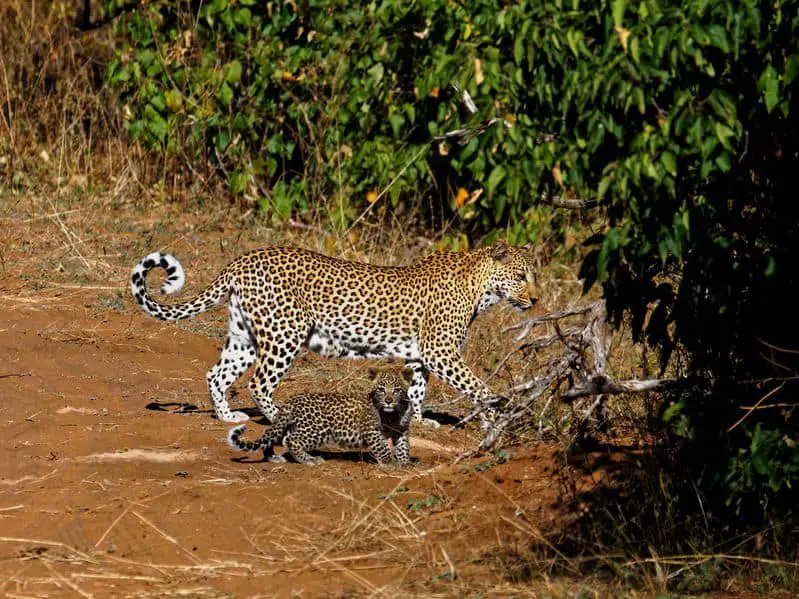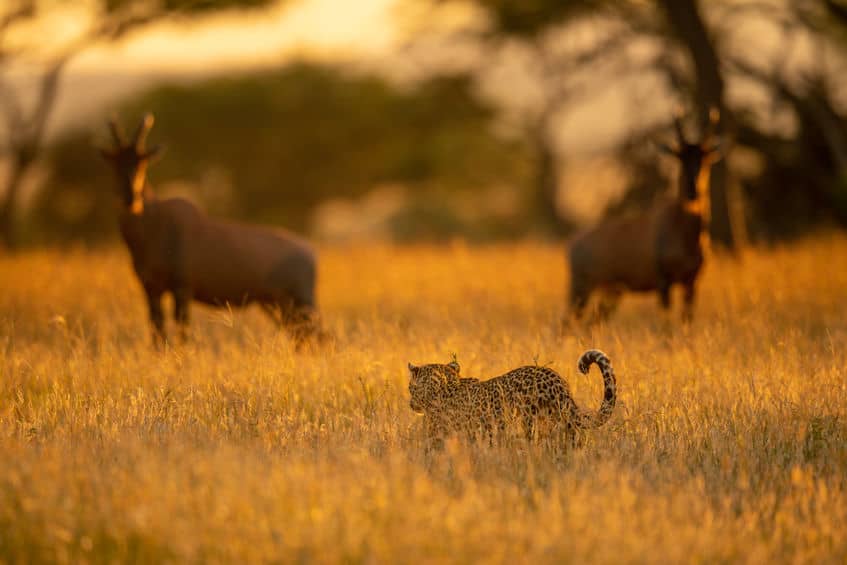
The life cycle of African leopards is full of interesting events and milestones. I have written this post to describe 14 of the most important events and periods in the lives of leopards.
The 14 facts I have written about in this post are listed in the same order as they happen in nature to give you the best possible insight into the life cycle of leopards from they are born and through adulthood.
Newborn Leopard Cubs
When it is time for female leopards to give birth, they find a secluded spot where they can give birth safely. They often have just one cub at a time but litters with 2 to 4 cubs are also very common. On some rare occasions, litters with as many as six cubs have even been observed.
At birth, the cubs weigh just over a pound (about half a kilo) and are so small that they can fit inside the palm of a hand.
Baby leopards are born without their well-known yellow or orange fur with the iconic pattern with circular or rosette-shaped markings. At birth, leopard cubs are almost entirely grey but over the next few months, their fur will start to look more and more like that of the adults.
Like many other animals, leopards are born with their eyes closed and the best way for them to have an idea of their surroundings is through smell. After between four and nine days, their eyes open.
Despite being born completely blind, leopards actually end up developing one of the strongest eyesights in the world which ends up giving them a huge advantage when it comes to hunting and general survivability. An adult leopards eyesight is seven times stronger than that of a human in low-light conditions
Some Leopards are Born With Black Fur
Most of the time, cubs will be grey and then slowly develop their characteristic yellow or orange fur with the iconic markings but on rare occasions, some of the cubs in a litter can have completely black fur.
Leopards with black fur are often referred to as black panthers.
A black panther is a genetic variation that can occur in many different types of cats. It is a very rare occurrence but a bit more common with leopards and jaguars than other types of cats.
Black panthers are born in litters where either the mother or the father of the cubs was also a black panther.
Leopards with black fur actually still have their well-known circular or rosette-shaped markings but they are not as visible as they are on their yellow or orange-colored siblings as the markings themselves are dark and therefore are better hidden in the black fur.
Spotting a leopard is not always an easy task in itself and takes some luck or skill (but take a look at this link for a couple of good tips. Opens in a new tab).
Spotting a black panther is a challenge on a whole new level as these not only have the same skills as other leopards that make them extremely elusive animals but also have a color that allows them to blend in perfectly with the darkness of the night which is when they are most active.
If you are interested in learning more about why leopards are active at night, take a look at this post (opens in a new tab).
This rare phenomenon is caused by the production of melanin which makes the leopard’s fur black. The process is often referred to as melanism.
Most black leopards, or panthers, have been observed in moist, tropical, and subtropical forests. Most of the panthers are found in Asia but several have also been observed in Africa.
The Cubs Are Hidden for the First Six Weeks

Before they grow up and turn into some of the most skilled hunters on the entire planet, leopards need to survive long enough to grow up.
Newborn leopards are very small and completely helpless. They are blind and cannot hear very well for the first several days of their lives.
To increase the chance of their cubs surviving, leopard mothers keep their cubs hidden for the first six weeks of their lives to avoid any unwanted contact with enemies.
Leopard cubs quickly grow bigger and stronger so every day they make it, their chances of reaching adulthood become higher and higher.
To provide additional safety and further increase the cubs’ chances of surviving, leopard mothers will usually move around every few days and try to find new, secluded, and hopefully safe spots to keep their cubs.
Keeping the cubs hidden and moving around every few days significantly reduces the risk of being found by other large predators who could potentially kill the cubs.
The biggest risks for leopard cubs include lions who can seek out leopard cubs and kill them either to reduce future competition or simply for sport. While they are very young, another dangerous and common enemy for leopard cubs is snakes who can often be big enough to kill or even eat a young and defenseless cub.
The Diet for a Newborn Leopard
From the day they are born and for the first few months of their lives, leopard cubs survive by just drinking milk from their mothers.
When they are around three months old, they will slowly begin to add meat to their diet as a supplement to the milk. Young cubs will begin to eat scraps from whatever prey animal their mother has caught and brought home.
Around the time meat is introduced in their diet, leopard cubs will also begin to follow their mothers when they go hunting so they can start to learn and practice this important life skill for themselves.
Learning to Hunt

When the cubs are around three to four months old, meat is slowly being introduced into their diet. At this point, the cubs will also start to practice hunting and other extremely important life skills that are needed to ensure survival.
One of the first vital skills leopard cubs begin to learn and practice is hunting. For several months, they will follow their mother around when she goes hunting. Here, they can observe and try to imitate her while she teaches them the important skill.
Leopards rely heavily on stealth and on being able to sneak up on unsuspecting prey animals when they hunt. This is extremely important for the young cubs to practice and they will often play around and practice sneaking up on each other or on inanimate objects such as stones or branches.
Over the next many months, the young cubs will practice and improve their hunting skills and when they are around two years old, they are some of the best and most efficient hunters in all of Africa.
A Change in Diet
As the cubs grow older and learn to hunt, they stop being dependent on milk from their mother and their diet will change and begin to look more similar to that of the adults.
Grown leopards have an extremely wide variety of animals they can eat and what they eat depends largely on their territory and what animals they can hunt there.
Leopards can eat almost any animal they can hunt ranging from tiny critters, beetles, birds, and fish and all the way up to large mammals such as kudus or even elands.
Their favorite type of prey, however, seems to be medium-sized antelopes such as impalas or springboks.
Leaving Their Mother
Around the age of two, the young leopards will have become proficient in hunting and will have acquired and trained all the necessary skills to survive on their own.
At this point, they will leave their mother and go out to live and survive on their own.
After the cubs are old enough to leave their mother and the mother is on her own again, she will quickly become fertile and ready for a new litter of cubs. Male leopards will be able to sense this and will usually seek out the females when this happens.
The young leopards who are now out on their own will reach sexual maturity between the age of 2 to 4 years old and are then ready to find a suitable mate and to start having offspring of their own. Young male leopards will generally be ready to mate sooner than females.
Perfecting Important Skills

Leopards already learn and begin to practice their most important skills such as hunting and climbing as young cubs and will already be very proficient at them when they have left the mother but now that the young leopards are all on their own, it is time to truly put those skills to the test and really perfect them.
Among the most important skills is of course hunting. Leopards are heavily reliant on being able to hunt efficiently.
Leopards hunt at night and their hunting success relies heavily on stealth and on their ability to glide through the shadows and go unnoticed when sneaking up on their target prey.
Leopards will often be able to get as close as within just fifteen feet (about five meters) of their target before they strike.
After a successful hunt, it is time to make use of another one of the most important skills leopards can learn to master. Climbing.
Leopards are extremely skilled climbers and when that skill is combined with their massive strength, you get something truly remarkable. Because not only are leopards impressively agile and able to navigate through and around the branches when climbing a tree, but they can also do so while carrying prey that is several times larger and heavier than themselves.
Carrying their prey up into a tree and securing it by hanging it over a large branch will significantly reduce the risk of losing the prey to other large predators such as lions, spotted hyenas, or African wild dogs.
Being such skilled climbers also gives leopards an advantage when being chased by other predators, namely the three mentioned just above, as these are not nearly as skilled climbers as leopards. Spotted hyenas and African wild dogs can actually not climb trees at all. Their bodies are built for running and endurance rather than for climbing.
So when they are being chased by other predators, leopards often escape by climbing up into a tree.
Leopards do, however, not at all only climb trees for such dramatic reasons as securing freshly caught prey from other hungry predators or to escape dangerous enemies.
Leopards also like to rest and sleep in trees and can often be seen laying down on a large branch high up in a tree. This provides the leopard with protection from large predators and shade from the warm, bright sun.
If you are interested in learning more about why leopards are often spotted in trees, take a look at this post (opens in a new tab).
Leopards are Solitary Creatures
The social structure and social behavior of different animals vary a lot and even big cats, who are otherwise more closely related to each other than many other animals, have very different social behaviors and preferences.
Male lions tend to be solitary in their nature and female lions live in groups (called prides) with other related females and their cubs.
Cheetahs are more or less the opposite as the female cheetahs are usually solitary creatures, although they stay with their cubs when they are young. Male cheetahs stay in small groups usually consisting of 3-5 male cheetahs who are often related to each other.
Leopards are unique from the two other big cats of Africa when it comes to their social behavior.
All adult leopards are solitary creatures. The only periods of their lives where leopards stay together are generally when a mother takes care of her cubs, which she does until they are around the age of two years old or during the mating season during which males and females will seek out each other.
While leopards are generally very solitary in their nature, it is not uncommon for female leopards and their offspring to meet with each other for a happy and joyful, but brief reunion.
Leopards Have Their Own Territory
Adult leopards are also very territorial animals and both the males and the females have their own territory which they defend from other leopards of the same sex. Male leopards and female leopards can, however, have overlapping territories.
Just like with most other cats, male leopards have a significantly larger territory than females and a single male territory can contain several female territories.
Despite being very territorial and protective of their own territory, there are actually no fixed borders and neighboring leopards can have overlapping territories. When this is the case, they will often stay at a respectful distance from each other and only use the shared part of their territory when the other one is not there.
Fully Grown Leopards Can Weigh as Much as Humans

The size of a fully grown African leopard can vary greatly and ranges from 37 to 128 pounds (17 to 58 kg) for the females and 44 to 200 pounds (20 to 91 kg) for the males.
These numbers definitely include some extremes as only very few leopards grow to weigh anywhere near 200 pounds (91 kg). Leopards of this size require excellent living conditions and are a rare occurrence even if they have that.
Most leopards weigh between 55 to 66 pounds (25 to 30 kg) with the females at the lower end of that range and the males at the higher end.
How large leopards grow and how much they end up weighing depends largely on several external factors, most of them related to the regions they are in and their territories such as how well it is suited for efficient hunting and perhaps most importantly, what type of prey and how much of it is available to them in their territory.
In areas with smaller prey, the leopards are naturally much smaller than in areas with a large supply of large but easy-to-catch prey such as impalas and springboks.
Female Leopards Often Mate With Multiple Males
Female leopards can go into heat multiple times throughout the year. It does not happen at a fixed schedule or a certain number of times per year as it does with many other animals.
Female leopards are in heat for around a week at a time and during this period, they will mate upwards of 100 times per day. They will usually mate with 2 to 3 male leopards during this time.
The reason why female leopards mate with multiple different males is to increase the cubs’ chances of survival as the males will not kill the cubs of a female they have mated with.
Only one of the male leopards will become the father of the cubs but as soon as a male and a female leopard have mated, the male will leave the cubs alone. Male leopards are otherwise known til kill cubs.
Time for Another Litter
After a succesful mating, the gestation period begins.
Since they can go into heat at any time of the year, female leopards can also give birth at any time of the year.
Female leopards are pregnant for 90 to 110 days after which they give birth to a new litter of cubs, usually 1 to 4 of them for whom the life cycle you have just learned about will start over.
The Lifespan of African Leopards
Leopards in the wild usually live for 10-12 years but can live for as much as 17 years under the right conditions and if they manage to avoid dangerous encounters with enemies when necessary.
If given good conditions, they can live for 23 years in captivity since threats such as natural enemies have been removed and potentially threatening diseases can be taken care of.

